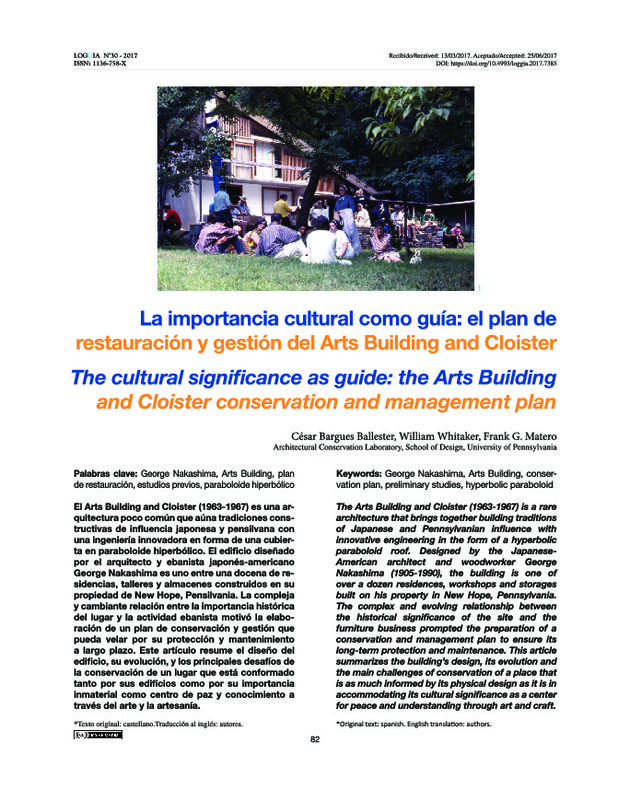JavaScript is disabled for your browser. Some features of this site may not work without it.
Buscar en RiuNet
Listar
Mi cuenta
Estadísticas
Ayuda RiuNet
Admin. UPV
La importancia cultural como guía: el plan de restauración y gestión del Arts Building and Cloister
Mostrar el registro sencillo del ítem
Ficheros en el ítem
| dc.contributor.author | Bargues Ballester, César
|
es_ES |
| dc.contributor.author | Whitaker, William
|
es_ES |
| dc.contributor.author | Matero, Frank G.
|
es_ES |
| dc.date.accessioned | 2018-01-02T10:44:59Z | |
| dc.date.available | 2018-01-02T10:44:59Z | |
| dc.date.issued | 2017-12-20 | |
| dc.identifier.issn | 1136-758X | |
| dc.identifier.uri | http://hdl.handle.net/10251/93724 | |
| dc.description.abstract | [EN] The Arts Building and Cloister (1963-1967) is a rare architecture that brings together building traditions of Japanese and Pennsylvanian influence with innovative engineering in the form of a hyperbolic paraboloid roof. Designed by the JapaneseAmerican architect and woodworker George Nakashima (1905-1990), the building is one of over a dozen residences, workshops and storages built on his property in New Hope, Pennsylvania. The complex and evolving relationship between the historical significance of the site and the furniture business prompted the preparation of a conservation and management plan to ensure its long-term protection and maintenance. This article summarizes the building’s design, its evolution and the main challenges of conservation of a place that is as much informed by its physical design as it is in accommodating its cultural significance as a center for peace and understanding through art and craft. | es_ES |
| dc.description.abstract | [ES] El Arts Building and Cloister (1963-1967) as una arquitectura poco común que aúna tradiciones constructivas de influencia japonesa y pensilvana con una ingeniería innovadora en forma de una cubierta en paraboloide hiperbólico. El edificio diseñado por el arquitecto y ebanista japonés-americano George Nakashima es uno entre una docena de residencias, talleres y almacenes construidos en su propiedad de New Hope, Pensilvania. La compleja y cambiante relación entre la importancia histórica del lugar y la actividad ebanista motivó la elaboración de un plan de conservación y gestión que pueda velar por su protección y mantenimiento a largo plazo. Este artículo resume el diseño del edificio, su evolución, y los principales desafíos de la conservación de un lugar que está conformado tanto por sus edificios como por su importancia inmaterial como centro de paz y conocimiento a través del arte y la artesanía. | es_ES |
| dc.language | Español | es_ES |
| dc.language | Inglés | es_ES |
| dc.publisher | Universitat Politècnica de València | |
| dc.relation.ispartof | Loggia, Arquitectura & Restauración | |
| dc.rights | Reconocimiento - No comercial - Sin obra derivada (by-nc-nd) | es_ES |
| dc.subject | George Nakashima | es_ES |
| dc.subject | Arts Building | es_ES |
| dc.subject | Plan de restauración | es_ES |
| dc.subject | Estudios previos | es_ES |
| dc.subject | Paraboloide hiperbólico | es_ES |
| dc.subject | Conservation plan | es_ES |
| dc.subject | Preliminary studies | es_ES |
| dc.subject | Hyperbolic paraboloid | es_ES |
| dc.title | La importancia cultural como guía: el plan de restauración y gestión del Arts Building and Cloister | es_ES |
| dc.title.alternative | The cultural significance as guide: the Arts Building and Cloister conservation and management plan | es_ES |
| dc.type | Artículo | es_ES |
| dc.date.updated | 2018-01-02T08:43:19Z | |
| dc.identifier.doi | 10.4995/loggia.2017.7385 | |
| dc.rights.accessRights | Abierto | es_ES |
| dc.description.bibliographicCitation | Bargues Ballester, C.; Whitaker, W.; Matero, FG. (2017). La importancia cultural como guía: el plan de restauración y gestión del Arts Building and Cloister. Loggia, Arquitectura & Restauración. (30):82-93. https://doi.org/10.4995/loggia.2017.7385 | es_ES |
| dc.description.accrualMethod | SWORD | es_ES |
| dc.relation.publisherversion | https://doi.org/10.4995/loggia.2017.7385 | es_ES |
| dc.description.upvformatpinicio | 82 | es_ES |
| dc.description.upvformatpfin | 93 | es_ES |
| dc.type.version | info:eu-repo/semantics/publishedVersion | es_ES |
| dc.description.issue | 30 | |
| dc.identifier.eissn | 2444-1619 | |
| dc.description.references | WILLIAM WHITAKER. George Nakashima's Arts Building and Cloister: Collection and lnterpretation Assesment. (Informe inédito). The Architectural Archives of the University of Pennsylvania, 2017. | es_ES |
| dc.description.references | DAVID KIMMERLY Y CATHERINE C. LAVOIE. George Nakashima Woodworker Complex. National Historic Landmark Nonimantion (Octubre 2012). Designación. Abril2014. | es_ES |
| dc.description.references | ANDI TROCI Modeling and Analysis of Plywood Shell Structures. (Tesina de master). Master avanzado en Análisis Estructural de Monumentos y Construcciones Históricas, Universidad Técnica Checa en Praga, 2016. | es_ES |
| dc.description.references | LEAH BRIGHT. Investigating the Preservation Needs of Objects within the George Nukashima Arts Building. WUDPAC, 2016. | es_ES |
| dc.description.references | JAMES SEMPLE KERR. The Seventh Edition Conservation Plan: A Guide to the Preparation of Conservation Plans for PlaceVs of European Cultural Significance. Australia Icomos, 2013. | es_ES |
| dc.description.references | PANKAJ VIR GUPTA AND CHRISTINE MUELLER, "Golconde: The Introduction of Modernism in India" in 2005 AIA Report on University Research (Washington, D.C.: AIA, 2006). | es_ES |








